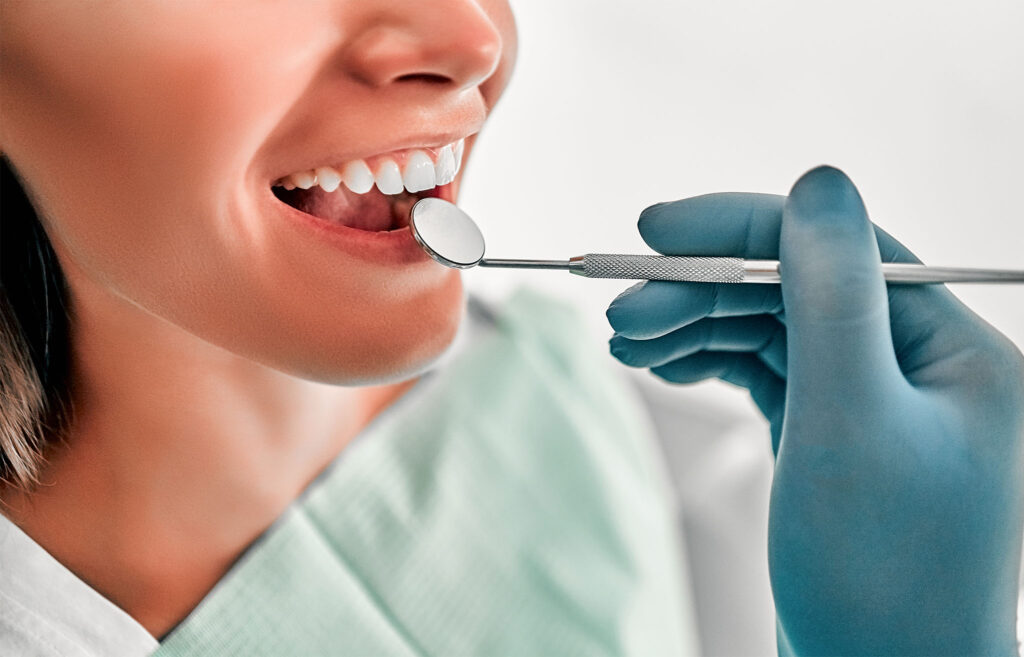
Periodontal treatment
Periodontics is a branch of dentistry that focuses on the treatment of the periodontium, its diseases, and related pathologies. Periodontium is a complex of tissues supporting the teeth: the gums, root cementum, alveoli tissues, and the fibres that connect them to the roots of the teeth. The periodontium is responsible for attaching and supporting the teeth in the bone sockets (alveolus). In addition, it consists of many blood vessels and nerves that are important to the body. Periodontium provides blood circulation to the teeth, allows the chewing load to be evenly distributed throughout the tooth, and protects the teeth from infections.
- Gum diseases and their causes
- Periodontal treatment
- How dangerous is periodontitis?
- What are the main symptoms of periodontitis?
- Is periodontal treatment painful?
- At what age are periodontal diseases more common?
- How to prevent periodontal diseases?
- Post periodontal treatment
- Periodontal treatment in our clinic
- Frequently asked questions
- Pricelist
Gum diseases and their causes
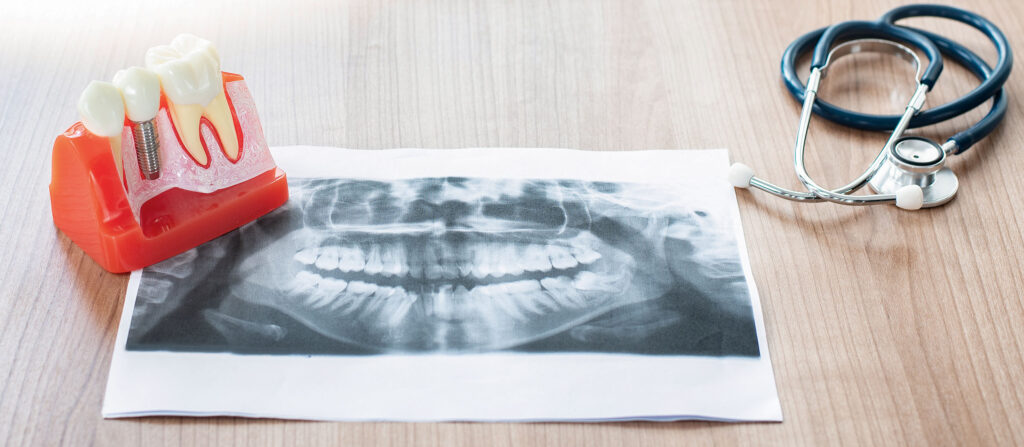
Periodontal diseases often cause an inflammatory process that can severely damage the bone and tissues, which surround and support the teeth, and can lead to tooth loss. The main causes of periodontal disease are:
- Destructive effects of pathogenic bacteria in the mouth.
- Professional oral hygiene servicing is performed rarely.
- Severe dental trauma and tooth decay.
- Overcrowding teeth or other occlusion defects.
Diabetes, immunodeficiency, and blood disorders also increase the risk of gum diseases.
In many cases, the onset and first stages of periodontal disease are completely asymptomatic. Therefore, a patient who does not visit for regular preventive dental check-ups runs the risk of not being aware of their disease, or that they may have an increased chance of developing it.
The most common periodontal diseases are gingivitis and periodontitis.
Gingivitis
Gingivitis is an initial form of inflammation of the gums that is usually caused by plaque accumulating on top, and under, the gum line. Gingivitis forms include acute (noticeable symptoms) and chronic (asymptomatic, without or with minimal pain). Gingivitis is classified not only by its form but also by its nature:
- Catarrhal gingivitis – causes redness, itching, bleeding during brushing, and slight pain in the gingival area. It is the most common type of gingivitis and is easily treated. However, it can signify the early stages of other periodontal diseases.
- Necrotizing ulcerative gingivitis – is led by formation of ulcers, bad breath, build-up of dark teeth tartar, and dying gum tissues. Is very difficult to treat. Failure to receive timely help can lead to formation of abscesses and necrosis.
- Hypertrophic gingivitis – causes excessive growth of gum tissues covering the roots of the teeth. It can lead to keratinization of the gingival areas.
- Atrophic gingivitis – causes receding gums, exposure of the necks of the teeth, and has a high risk of loss of healthy teeth.
If not diagnosed in time and not treated properly, gingivitis can progress to a more severe form of inflammation called periodontitis.
Periodontitis
Periodontitis is a chronic inflammation of the tissues surrounding the teeth, which destroys the supporting bone of the tooth. Main symptoms of periodontitis are redness, bleeding of the gums, bad breath, gum pain, as well as deep periodontal pockets.
Without proper treatment, developing periodontitis damages periodontal ligaments, gums, cementum, and the alveolar bone. Eventually, the gums begin to gradually detach from the teeth, the bone mass shrinks and the periodontal pockets deepen. As a result, the tooth does not hold firmly and begins to move. In the later stages of the disease, the tissues holding the tooth are irreversibly damaged and the tooth is lost.
The symptoms of periodontitis depend on the nature and form of the disease:
- Localised – inflammation occurs in a small and contained area of the gums, with the remaining periodontal tissues being unaffected by the disease. Usually, this type of periodontitis develops if the gum tissue is being regularly damaged in one place. In most cases, it is sufficient to just prevent further damage to the area, by removing the factor causing damage..
- Generalized – inflammation of all the gums in one or both jaws. The most common form of the disease.
- Acute – severe gum pain, swelling and bleeding. Occasionally gum abscesses may form.
- Chronic – long-term inflammation of the gums, causing acute exacerbation, swelling and pain. Teeth become unstable over time.
- Purulent – painful inflammation of the gums, accompanied by the formation of purulent wounds. Abscesses of the gums or jaw may form without proper treatment.
Aggressive periodontitis is a rare subset of the disease that requires special treatment. They develop rapidly because they are often caused by dangerous pathogenic bacteria:
- Rapidly progressive periodontitis – occurs in patients aged 15-35 years. Involves risks of loss of bone tissue from almost all teeth.
- Necrotizing ulcerative periodontitis – usually develops as a result of untreated necrotizing ulcerative gingivitis. The disease has cyclic activity, rapidly destroys periodontal tissue, and causes the formation of interdental cavities.
Highly qualified periodontists working in our clinics treat all types of gum diseases. Each periodontal inflammation requires an individual treatment plan and different procedures.
Periodontal treatment
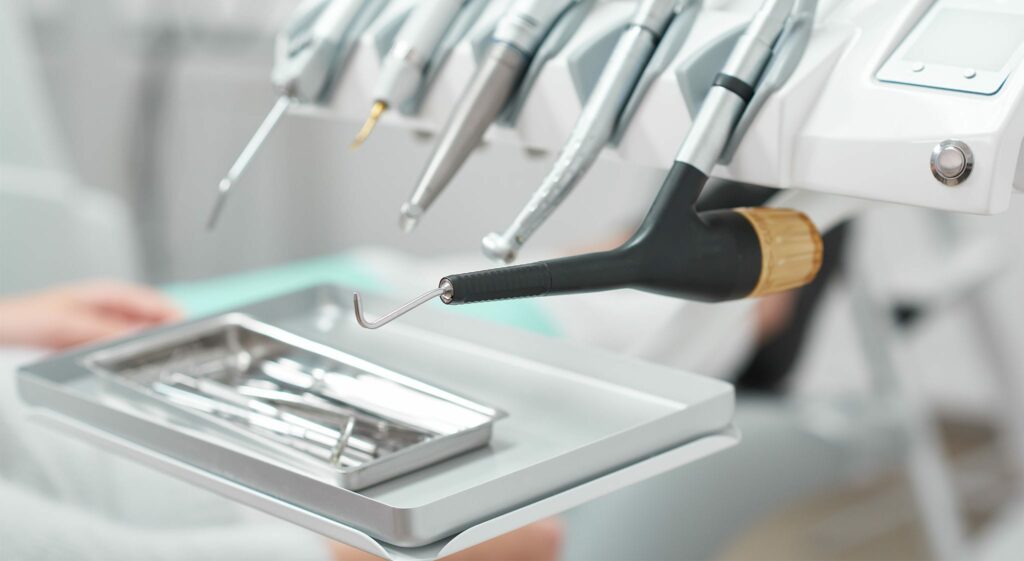
Modern methods of treating periodontal diseases can achieve very good results if the treatment is started as early as possible and the problem is approached comprehensively. The periodontal treatment plan usually consists of therapeutic treatment (treatment of concomitant diseases) and local treatment (removal of periodontal damage). This includes:
- Performing professional oral hygiene.
- Medication (antibiotics, lotions, healing toothpastes).
- Physiotherapy.
- Personal oral hygiene training.
- Dietary plan.
- Prescription of food supplements (vitamins of groups C, P and PP).
In some cases, the following may also be performed:
- Periodontal surgery.
- Rational prosthetics.
- Orthodontic treatment.
- Temporary fixation of unstable teeth using a retainer.
Depending on the stage of the periodontal lesion and the individual diagnosis, the periodontist chooses between conservative (therapeutic) and surgical treatment.
Conservative periodontal therapy
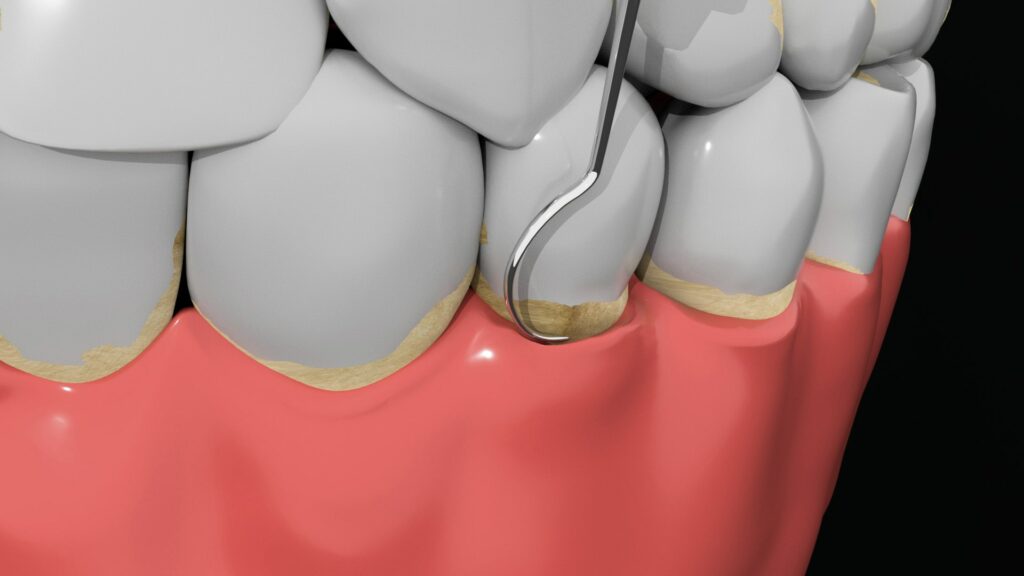
Conservative treatment of periodontal diseases includes all preventive dental hygiene procedures. Sometimes, a closed gum curettage may also be performed – a periodontal procedure that includes deep cleaning of the tooth pockets from dental plaque. Depending on the clinical situation, the procedure can be performed in a minimally invasive manner or by making an incision in the gingival mucosa. Cleaning is performed using special periodontal instruments, ultrasound devices, and a specialised laser. Sometimes the cleaning process can be combined with the restoration of destroyed gum tissue and plastic gum surgery.
Closed curettage is performed under local anaesthesia without damaging the gum flap. This therapeutic procedure is performed to treat simple forms of gingivitis and periodontitis. Closed curettage is considered a minimally invasive method.
Closed curettage can be:
- Manual – the doctor uses a special dental hook to clear the hard tartar that has accumulated under the gum flaps.
- Ultrasound – cleaning is performed using an ultrasonic scaler, which effectively breaks down tartar and destroys bacterial biofilms under the gums. At the same time, an antiseptic solution is released from the ultrasonic scaler head, which neutralizes the pathogenic microflora growing in the gum pockets.
- Laser – used to remove the tissues severely damaged by bacteria. Laser removal ensures instant tissue coagulation, so it does not cause bleeding and has a rapid postoperative healing. Local anaesthesia is used to relieve pain during the procedure.
Surgical periodontal treatment

Gingival recession coverage
Gum recession is a process where the gum tissue wears off, exposing the roots of the teeth. Recession is a noticeable cosmetic defect that can lead to serious dental problems and even tooth loss. Gum recession can be prevented by proper oral hygiene and regular dental check-ups.
There are a variety of modern treatment methods for gum recession, the most appropriate of which is determined by the periodontist, based on the condition of the patient’s gums. In severe cases of gum recession, surgical treatment is performed and the recession is covered manually. Surgical recession coverage is a form of plastic surgery, during which the solid tartar deposits are cleaned and the areas affected by recession are covered by transplanting tissues from the patient’s healthy gums. The operation is safe and performed under local anaesthesia.
Gum flap surgery
‘Periodontal pockets’ develop in patients with periodontitis. These pockets accumulate pathogenic bacteria that damage the bone and tissues around the tooth’s root. Failure to diagnose this in time, and delaying a visit to a dental clinic, can lead to generalized periodontitis (inflammation of the entire periodontium). Periodontitis may cause irreversible damage to the cementum, periodontal ligament and the alveolar bone surrounding the teeth.
Gum flap surgery may be performed when the conservative treatment methods are not sufficient, severe inflammation is observed, and the periodontal pockets become deepened. Gum flap surgery is one of the most effective surgical methods used to treat periodontitis. During the operation, the gums are surgically uncovered, the periodontal pockets are manually cleaned and disinfected, and the supporting tissues lost during the disease are restored.
Vestibuloplasty
Vestibuloplasty is a periodontal surgery designed to remove excess gum tissue and restore the gums to their anatomically correct shape. This operation is performed for aesthetic purposes and before dental implantation, when the implantation site is prepared. In the latter case, the gums are formed in such a way as to support the dental implant and to ensure its stability.
There are several methods for performing vestibuloplasty, each of which has specific indications. The periodontist chooses the most optimal technique after examining and evaluating the condition of the patient’s gums.
Treatment of complex periodontitis may require procedures from other specialities of dentistry (orthodontics, dental surgery, therapeutic procedures, etc.). The specific treatment methods for periodontitis are determined individually, after consultation with a periodontist. Treatment also highly depends on the severity of the inflammatory process and the condition of the patient’s oral mucosa and teeth. Dentists working in our clinics always strive to ensure a minimally invasive periodontal treatment, preserving as much natural healthy tissue as possible. Surgical treatment is only used when conservative treatment is not enough to treat the disease.
How dangerous is periodontitis?
The development of periodontitis takes a long time and is sometimes asymptomatic. If not diagnosed in time, it can progress to a chronic stage, which can lead to the loss of healthy teeth. In addition, later stages of periodontitis can complicate eating, cause bite defects, damage the smile’s aesthetics, and alter diction. The spread of the infection to the surrounding tissues can also cause various inflammatory diseases. These include disrupting the functioning of the gastrointestinal tract, endocrine, and cardiovascular system. Gum diseases also weaken and negatively impact the general condition of the body and the patient’s well-being.
Therefore, it is very important to book regular dental check-ups. In the event of periodontitis, this ensures its early diagnosis and will be much faster, simpler, and cheaper to treat.
What are the main symptoms of periodontitis?
Among the most common symptoms of periodontitis are:
- Redness and bleeding of the gums.
- Large deposits of hard and soft dental plaque.
- Deepened periodontal pockets.
- Dental bone atrophy.
- Exposure of tooth roots.
- Formation of abscesses.
- Instability of the teeth.
- Gum swelling and pain.
Is periodontal treatment painful?

There is no reason to worry about the discomfort during the treatment. Modern periodontology uses the latest equipment which allows our dentists to perform advanced surgical techniques and use effective anaesthetics. Periodontal surgeries performed in our clinics are completely safe and painless.
At what age are periodontal diseases more common?
Age is not a decisive factor when it comes to periodontology. Surprisingly, a large proportion of people may suffer from some forms of gum diseases without knowing. According to the World Health Organization, 95% of the adult population (60-95% of whom are 20-44 years old) and 80% of children worldwide show certain signs of periodontal diseases. Therefore, gum diseases are among the most common problems faced in modern dentistry.
How to prevent periodontal diseases?
Although periodontal diseases are common, it is possible to protect your teeth and gums by following these very simple rules:
- Regularly visiting the clinic for dental check-ups (at least 2 times a year).
- Following proper oral hygiene (brushing your teeth at least twice a day using a toothbrush, floss, and other tools recommended by your dentist).
- Attending regular professional oral hygiene appointments in the clinic – at least 2 times a year.
- Following a balanced diet (ensuring proper intake of vitamins, calcium and other minerals).
Post periodontal treatment
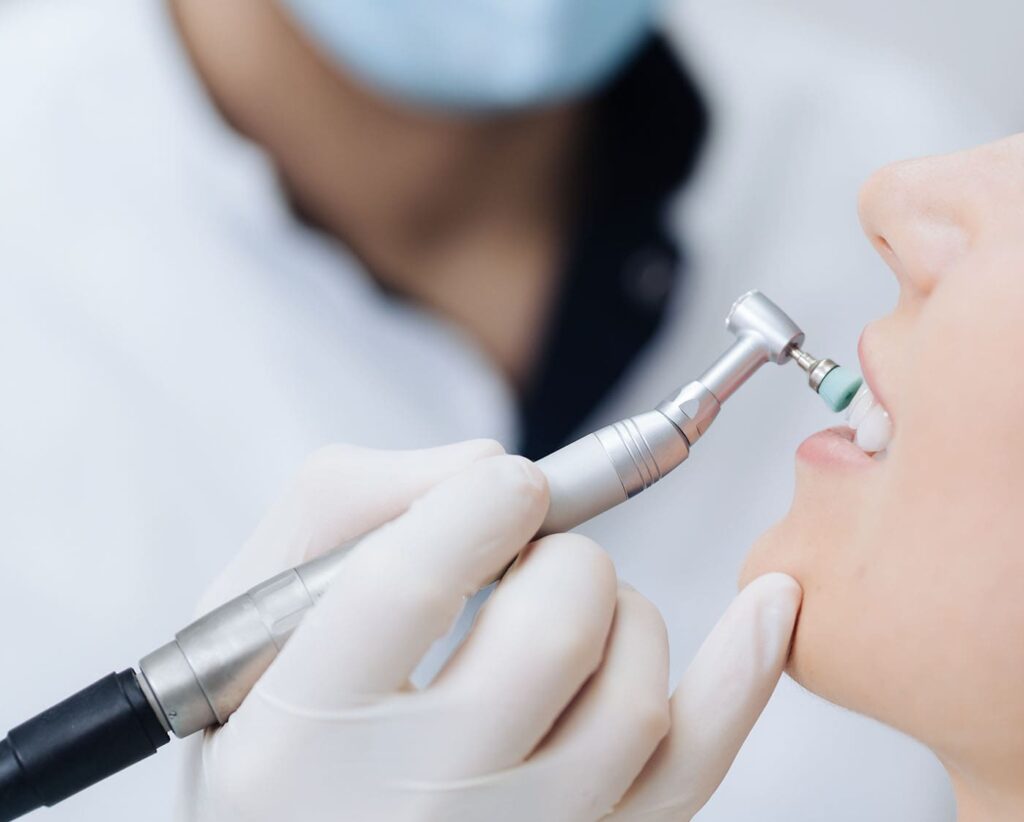
Post treatment of periodontitis requires regular visits to the dentist to prevent recurrence of the disease. After the periodontal operation, the periodontist gives the patient detailed recommendations. If required, the periodontist prescribes a course of antibiotics, special antibacterial rinsing fluids and gels, which slow down the formation of dental plaque and accelerate the regeneration of gum tissues.
Often, periodontologist’s rehabilitation recommendations will include reducing exercise, avoiding sudden temperature changes, consuming soft and light meals, and performing regular oral hygiene, as well as regular professional oral hygiene appointments (2-4 times a year).
Periodontal treatment in our clinic
The highly qualified periodontists working in our clinic have long-term experience and follow the latest methods of diagnosis, prevention, and treatment of periodontal diseases.
Professional consultation with an experienced specialist will help you ensure the health of your teeth and gums. You will also get important recommendations for maintaining proper oral hygiene, identify the possible occurrence of dental diseases in time, and get the best periodontal treatment.
Our clinic values our patients’ health, time, and comfort. Therefore we offer a modern, painless, and effective periodontal treatment.
Frequently asked questions
Pricelist
Periodontal treatment
| Conservative periodontal treatment (1 visit) | 150 € |
| Periodontal pocket deep cleaning (1 tooth) | 20 € |
| Periodontal surgery (1 tooth) | 120 € |
| Clinical extension of tooth crown | 220 € |
| Vestibuloplasty in one quarter (price without materials) | 240 € |
| Recession coverage (1 tooth) | 250 € |
| Gum flap surgery | 150 € |










